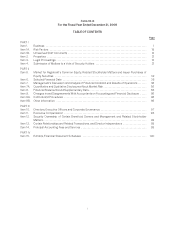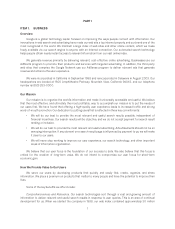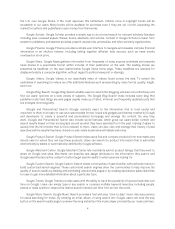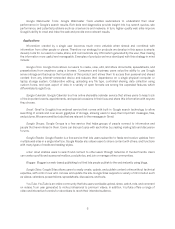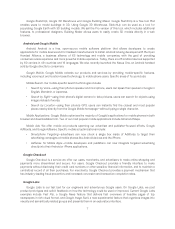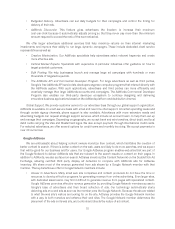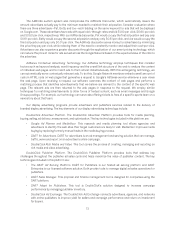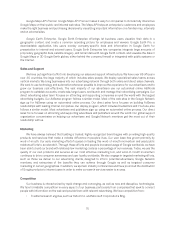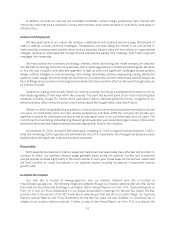Google 2009 Annual Report Download - page 26
Download and view the complete annual report
Please find page 26 of the 2009 Google annual report below. You can navigate through the pages in the report by either clicking on the pages listed below, or by using the keyword search tool below to find specific information within the annual report.The Technology Behind Search and Our User Products and Services
Our web search technology uses a combination of techniques to determine the importance of a web page
independent of a particular search query and to determine the relevance of that page to a particular search query.
Ranking Technology. One element of our technology for ranking web pages is called PageRank. While we
developed much of our ranking technology after Google was formed, PageRank was developed at Stanford
University with the involvement of our founders and was therefore published as research. PageRank is a query-
independent technique for determining the importance of web pages by looking at the link structure of the web.
PageRank treats a link from web page A to web page B as a “vote” by page A in favor of page B. The PageRank of a
page is the sum of the pages that link to it. The PageRank of a web page also depends on the importance (or
PageRank) of the other web pages casting the votes. Votes cast by important web pages with high PageRank
weigh more heavily and are more influential in deciding the PageRank of pages on the web.
Text-Matching Techniques. Our technology employs text-matching techniques that compare search queries
with the content of web pages to help determine relevance. Our text-based scoring techniques do far more than
count the number of times a search term appears on a web page. For example, our technology determines the
proximity of individual search terms to each other on a given web page, and prioritizes results that have the search
terms near each other. Many other aspects of a page’s content are factored into the equation, as is the content of
pages that link to the page in question. By combining query independent measures such as PageRank with our
text-matching techniques, we are able to deliver search results that are relevant to what users are trying to find.
Infrastructure. We provide our products and services using our own software and hardware infrastructure,
which provides substantial computing resources at low cost. We currently use a combination of off-the-shelf and
custom software running on clusters of commodity computers. Our considerable investment in developing this
infrastructure has produced several benefits. This infrastructure simplifies the storage and processing of large
amounts of data, eases the deployment and operation of large-scale global products and services, and automates
much of the administration of large-scale clusters of computers. Although most of this infrastructure is not
directly visible to our users, we believe it is important for providing a high-quality user experience. It enables
significant improvements in the relevance of our search and advertising results by allowing us to apply superior
search and retrieval algorithms that are computationally intensive. We believe the infrastructure also shortens our
product development cycle and lets us pursue innovation more cost effectively.
How We Provide Value to Our Advertisers and Content Owners
Google AdWords
For advertisers seeking to market their products and services to consumers and business users over the
internet, we offer Google AdWords, an auction-based advertising program that lets advertisers deliver relevant ads
targeted to search queries or web content across Google sites and through the web sites of our Google Network,
which is the network of third parties that use our advertising programs to deliver relevant ads with their search
results and content. The Google Network is also increasingly encompassing different forms of media as well,
including content providers who use our advertising programs to deliver ads in online video, television and radio
broadcasts. AdWords is accessible to advertisers in 41 different interface languages.
8



